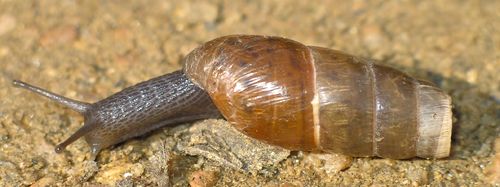by Valerie
June, 2014Decollate Snail
Why would a snail with a broken shell be a featured animal? Perhaps the name decollate snail (Rumina decollata) will provide the clue. Yes, this snail ALWAYS has a broken off shell, at least when it is an adult. A native of the Mediterranean area, the decollate snail has been in the U.S. for at least 160 years. It is quite common in the South and can endure light freezes as well as dry conditions. During hot and dry periods, the snails hide under rocks and logs, sometimes in large groups. When it is cooler and wetter, such as during the night and after rains, this species can be seen crawling about on the ground, but almost never on plants. Unlike other non-native snails, which are often garden pests, this species is a predator. While it will eat vegetation, it prefers the flesh of its fellow mollusks and is an active hunter, following the slime trails of its prey. I have seen this snail attack (which takes quite awhile) and also found it eating smaller snails, its head buried deep into the other's shell. Although the decollate snail helps cut down numbers of herbivorous snails, it preys equally on both native and invasive species, as well as on beneficial earthworms, feeding on eggs and small individuals. Back to the broken off shell. I actually found one sizeable individual that had a complete shell; it tapered to a long, graceful point. I've seen hundreds of these snails and the only others with complete shells were very young and had just a few whorls. As the snail grows it intentionally wears off the end point of its shell, rubbing against rough objects that can break the brittle structure. It makes sense for an active snail to want to lighten its load and be more maneuverable, and the shorter shell certainly facilitates that end. |